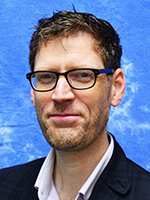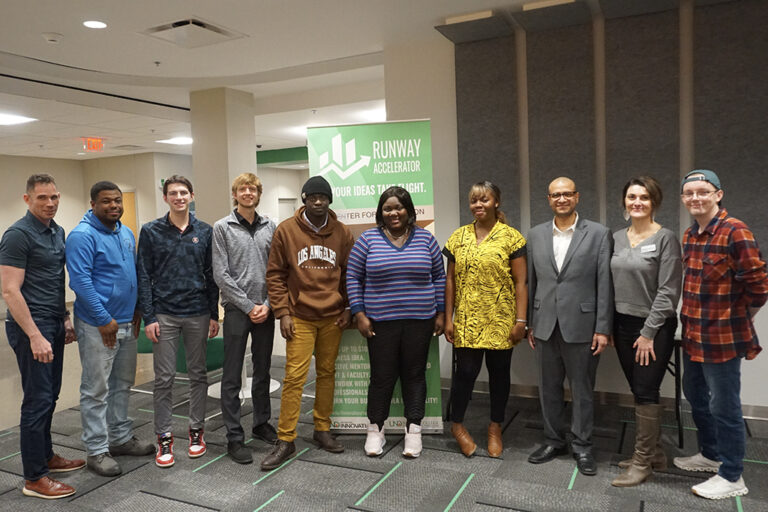First nations, first graduates
First graduates of world’s first doctoral program in Indigenous Health walk across stage at UND

Editor’s note: This story first appeared in the Summer 2023 issue of North Dakota Medicine, a quarterly print publication of the UND School of Medicine & Health Sciences.
By Brian James Schill
“I have a dream of testifying before Congress,” smiles Cole Allick from his Washington State University office in Seattle. “I know it’s probably not a high priority for a lot of other people, but I want to be on C-SPAN.”

Fresh off the successful defense of his doctoral dissertation on Alzheimer’s in the Indigenous community, Allick has become the first graduate of the UND School of Medicine & Health Sciences (SMHS) doctoral program in Indigenous Health, managed by the School’s first medical college-based Department of Indigenous Health.
Graduating this summer, and being the first program grad by virtue of a surname that starts with “A,” Allick, who hails from a small town on the edge of the Turtle Mountain Reservation called St. John, N.D., recognizes the implicit “nerdiness” of his dream to appear on America’s public affairs television network. Even so, such an advocacy-oriented goal is a result of the pragmatism he had cultivated even before matriculating into the Ph.D. program in 2020.
“I already see a lot of really great opportunities to use my research and my science as a tool to help people,” continues Allick, who took an undergraduate degree from UND to Washington State, where he earned a Master of Health Administration degree before “coming home” to UND’s online Ph.D. program. “I can’t just [research] for the sake of a publication. A publication on my [curriculum vita] is wonderful, but I need it to turn into something else. Actionable steps.”
Research in action
This community-based orientation is, in a way, a core feature of UND’s newest doctoral program, says Melanie Nadeau, interim director of both the degree program and the Department of Indigenous Health.
“One of the beautiful things about our program is that we really represent an interdisciplinary applied research portfolio for students, as well as an academic track,” explains the Turtle Mountain native who was the first epidemiology doctorate with an Indigenous background to graduate from the University of Minnesota’s School of Public Health. “These individuals have a research focus in all areas that you can imagine. Cole – he’s really focused at the policy level. And we have students studying maternal child health, Indigenous methodology, and trauma. We have a student who is a director of tribal health looking at reducing suicide. So, these students are all over the place, and the work they’re already doing is just amazing.”
Established in 2020 by Dr. Donald Warne, the former director of the SMHS Indians Into Medicine (INMED) program who in 2022 became the Provost Fellow for Indigenous Health Policy at Johns Hopkins University, the UND doctoral program in Indigenous health was something of a leap of faith, says Nadeau. The Indigenous faculty at the SMHS had long recognized the nationwide lack of such a degree program in the U.S., and that there was a cohort of potential students interested in such a program. But no one knew if or when such hypothetical students would actually apply to a new program without a track record – in North Dakota, no less.
Apply they did, though. In droves.
“It’s obvious that it was a huge need,” continues Nadeau, noting that the program’s initial student cohort of 18 total students has grown to more than 40 students of various years and backgrounds. “I have to say that right out of the gate we’ve been competitive. And we’ve pretty much reached our max now.”
Part of the program’s success and attractiveness, she says, hinges on its design: a mostly-online program offering two tracks (applied and academic studies) and multiple plans for completing coursework in three, four, or five years, depending on the student’s level of experience and lifestyle, for example working full-time while going to school. In that spirit, the program’s dissertation design asks students to produce not a single extended research study but multiple policy papers or research studies that give students more than one potential publication before they even graduate.
Local, national, and international
Furthermore, the program’s faculty relish the opportunity to mentor students and connect them with relevant players in the field of Indigenous health from around the country – and world.
This, at least, has been soon-to-be graduate Courtney Fischer-Claussen’s experience.
“I’ve already been able to present on the preliminary results of our research at the International Diabetes Federation Congress in Portugal this past December,” explains the Eagle Butte, S.D., native of her effort to help develop a systematic review of diabetes prevalence among Indigenous populations across the globe. “This has been a really incredible experience. It was nice to be able to meet our international team made up of Indigenous and non-Indigenous researchers from all over. We’re preparing our manuscript now, which is the part of my dissertation, and we’re hopefully submitting it to The Lancet’s Diabetes and Endocrinology.”
This “international” component of her doctoral dissertation is but one of three projects Fischer-Claussen has been working on over the past several years at UND. The “local” part of her dissertation is a “concise and comprehensive guide,” she says, that provides cultural protocol to researchers and other professionals who approach Indigenous communities as research subjects. Likewise, her “national” project involves drafting a policy brief that will help, she hopes, remove the federal restrictions on dual participation in the Supplemental Nutrition Assistance Program (SNAP) and the Food Distribution Program on Indian Reservations (FDPIR).
“One of my previous positions was as the American Indian Foods Program Assistant Director, which is housed under the Intertribal Agriculture Council,” Fischer-Claussen says. “It’s prohibited to participate in both FDPIR and SNAP simultaneously, so we’re looking at the health impact of restricting dual participation in these programs and tying that to food insecurity and the health of Indigenous populations on a national level.”
Despite her interest in national and international Indigenous health policy, Fischer- Claussen knows that her heart remains in the Dakotas.
“I’m definitely very connected to my family, to my home community,” she reflects, thinking about her own pending graduation. “I’m currently a little bit outside of my home community, being in the Black Hills, but it’s still traditionally Lakota land out this way. I definitely see myself working within the region that I’m in now.”

The state of Indigenous health
This new, cross-disciplinary generation of Indigenous health specialists can’t come soon enough, says Nadeau, whose own research tends to focus on longevity and mortality in the Indigenous population, not to mention the continuing health disparities between the Indigenous and non-Indigenous communities.
“The North Dakota tribes range from 6 to 9 percent of the population who are age 65 and older, while in North Dakota generally that number is 14 percent – and this population in Tribal communities is significantly more likely to suffer from one or more disabilities,” she laments, adding that many such statistics are a result of both the persistent poverty within the Indigenous community and the historical trauma that continues to affect contemporary American Indians. “Infant mortality is through the roof for Native people compared to whites. Then, the things we have less of – Alzheimer’s, hypertension – are because we just don’t live long enough.”
Such figures are proof-positive of the need for not only a Department of Indigenous Health in a medical college setting – one which complements an INMED program that has produced 274 Indigenous physicians over the past 50 years – but a doctoral program that is now producing graduates primed to make a direct impact on Indigenous health at the research, policy, and public health levels.
Having fallen quite by accident into Alzheimer’s research, Allick adds that the relative absence of Alzheimer’s disease in the Indigenous community means that both resources for and knowledge about the condition are hard to come by in Indian Country.
“I think patchwork is the best way to describe it – and that’s not just for resources like insurance and access to facilities, but even education,” he says, describing his dissertation, which will help fill the knowledge gap on culturally-competent Alzheimer’s resources and care for Indigenous Elders. “There’s basically one place for you to go: the Alzheimer’s Association. They’re trying to do a lot of really great work to be kind of that one-stop shop. But there are still some opportunities to really solidify resources at the Tribal level, map out how each tribe is providing those resources, or at least helping direct elders in their communities to these resources.”
The other portion of Allick’s thesis is a chapter on long-term care support and services for Elders slated to be included in a forthcoming textbook on American Indian health policy being edited by Warne. Such a book follows Warne’s and Chair of the SMHS Department of Surgery Cornelius “Mac” Dyke’s 2021 anthology American Indian Health Disparities in the 21st Century. Published by Cambridge Scholars on Indigenous People’s Day 2021, the first-of-its-kind book describes in often painful detail the disparities in both incidence and outcomes between the American Indian/Alaska Native community and the rest of the population living in the United States – for the same conditions.
All of this, suggests Nadeau, signals that things are moving in the right direction for Indigenous health, if slowly. Part of that movement includes embedding more Indigenous health content, including an elective on health equity, into the medical curriculum.
“[The class] is currently an elective, but we’re hoping that we can move this conversation into a space where it’s required for all of the students,” says Nadeau, thinking of not only medical students, but future physical and occupational therapists, physician assistants, and medical laboratory scientists. “And then there’s some holistic healing [education] that’s going across the [interdisciplinary] curriculum. We really want to be unified in those efforts to ensure that we’re including the breadth and depth of what’s needed.”
About the author:

Brian James Schill is director of Alumni and Community Relations at the UND School of Medicine & Health Sciences.


